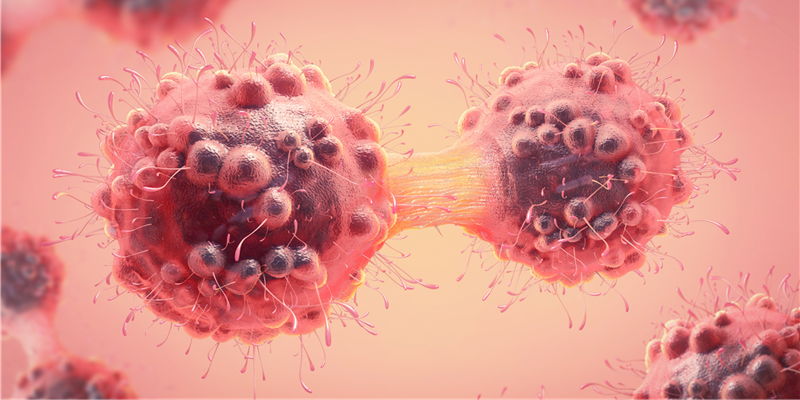Tumors are well organized and follow a strict set of rules. Scientists have identified 11 universal pillars or traits of human malignancy that give it the capacity to grow, invade surrounding tissues, survive in the circulation, and spread to distant organs. Collectively, these are called the “hallmarks” of cancer, and therapeutically targeting them can enhance standard treatment and improve your chances for achieving remission and long-term survival:
- Resistance to apoptosis (cell death): Apoptosis is a protective mechanism by which cells are programmed to die if they become damaged and potentially harmful. Cancer cells bypass this mechanism. Therapeutic target: Activate caspase protease enzymes and downregulate TP53-Induced Glycolysis and Apoptosis Regulator (TIGAR) protein.
- Replicative immortality: Normal cells die after a finite number of cell divisions. Cancer cells bypass this limit and are capable of infinite divisions (immortality) and sustained proliferation. Therapeutic target: Deactivate telomerase and destabilize telomeres.
- Evading immune attack: Cytotoxic T-cells (CTCs) and natural killer (NK) cells are the main anti-cancer immune cells. CTCs and NK cells can be rendered impotent by immunosuppressive cancer-associated fibroblasts (CAFs), tumor-associated macrophages (TAMs), and T-regulatory cells (Tregs) in the tumor microenvironment. Therapeutic targets: Increase the number and competency of CTCs and NK cells, reprogram CAFs and TAMs, and suppress the activity of Tregs.
- Genetic instability: DNA is damaged thousands of times during each cell division. That damage must be repaired, including in cancer cells. Otherwise, the cells may die due to this damage. Therapeutic target: Inhibit the enzyme known as PARP (poly ADP-ribose polymerase) used by cells to repair damage to their DNA.
- Altered metabolism and deregulated cellular energetics: The metabolism of cancer cells and the tumor stroma is different from normal cells. Cancer and stromal cells use alternative metabolic pathways to generate energy and building blocks to fuel malignant growth and spread. Therapeutic targets: Disable metabolic coupling between cancer cells and stromal cells, and deprive cancer of the high-energy nutrients it needs (i.e., glucose, glutamine, fatty acids, ketones, and lactate).
- Inflammation: Local or systemic inflammation induced by the tumor microenvironment acts as a major driver of cancer. Therapeutic target: Suppress local and systemic inflammation.
- Tumor hypoxia and angiogenesis: A growing tumor soon outstrips its oxygen and blood supply and needs to grow new blood vessels to deliver oxygen and nutrients. To orchestrate this, cancer cells boost the production of growth factors that stimulate angiogenesis. Therapeutic target: Inhibit hypoxia-inducible factors and vascular endothelial growth factor (VEGF).
- Invasion and metastasis: Cancer cells invade surrounding tissue and spread (metastasize) to distant sites in the body. Therapeutic targets: Inhibit HGF (hepatocyte growth factor), c-Met (mesenchymal-epithelial transition factor), lymphangiogenesis (growth of new lymph vessels), and exosome release.
- Sustained proliferative signaling: Cancer cells can permanently activate signaling pathways that promote excessive growth. It’s like the accelerator pedal is stuck. Therapeutic targets: Inhibit cancer-promoting MDM2 oncogene and block epidermal growth factor receptor (EGFR).
- Evading growth suppressors: To prevent overcrowding, normal cells have mechanisms that prevent excess cell growth and division. In cancer cells, tumor suppressor proteins are altered so they don’t prevent cell division. It’s like the brakes don’t work. Therapeutic targets: Unmutate and activate the cancer-suppressor p53 gene and inhibit cyclin-dependent kinases (CDKs).
- Reversal of the pH gradient: In normal cells, the intracellular environment is more acidic (lower pH), and the extracellular environment is more alkaline (higher pH). In cancer cells, this is reversed, where the intracellular environment is more alkaline, and the extracellular environment is more acidic. This condition enables tumors to grow and spread, resist the effects of chemotherapy, and inhibit immune attack. Therapeutic targets: Decrease the pH of the intracellular environment of cancer cells and increase the pH of the extracellular environment by inhibiting membrane carbonic anhydrases and monocarboxylate transporters.
Comments from Dr. Thomas: If you or a loved one are being treated for cancer, to improve your/their chances of beating the disease, be sure to ask the oncologist how many of the above hallmarks of cancer he/she is targeting. If it is not all eleven hallmarks, to address the ones that are being ignored, I urge to you seek the services of a physician who possesses a deep understanding of the complex biology of cancer and is educated and experienced in integrative therapies.
